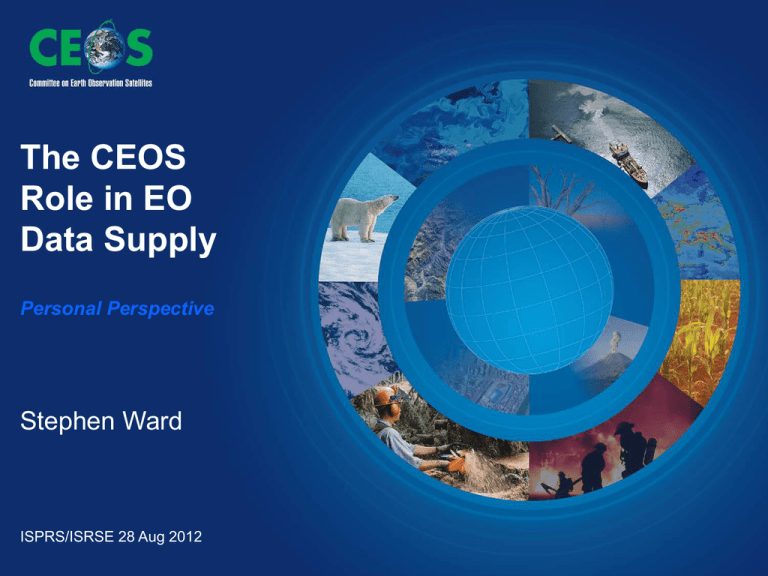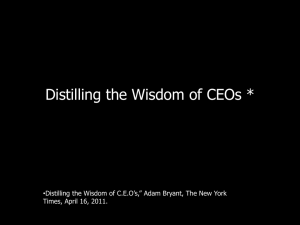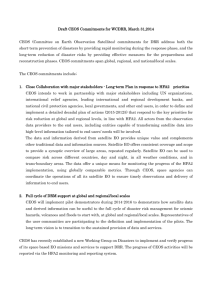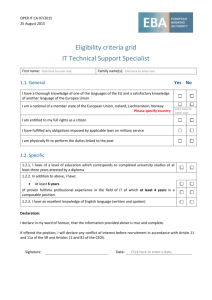The CEOS Role in EO Data Supply
advertisement

The CEOS Role in EO Data Supply Personal Perspective Stephen Ward ISPRS/ISRSE 28 Aug 2012 Slide: 1 ISPRS/ISRSE, Melbourne, 28 August 2012 Contents • CEOS • 3 phases of CEOS history - Basic interoperability & standards User Engagement (IGOS-P) Space segment for the GEOSS (GEO) • Current priorities 2 CEOS • Established in 1984 under auspices of G-7 Economic Summit of Industrialised Nations • Focal point for international coordination of space-related Earth Observation (EO) activities • Optimize benefits through cooperation of members in mission planning and in development of compatible data products, formats, services, applications, and policies • Operates through best efforts of Members and Associates via voluntary contributions • 30 Members (Space Agencies), 22 Associates (UN Agencies, Phase A programs or supporting ground facility programs) 3 Primary Objectives of CEOS 1. To optimize benefits of space-borne Earth observations through: • • Cooperation of its Members in mission planning Development of compatible data products, formats, services, applications, and policies; 2. To serve as a focal point for international coordination of space-related Earth observation activities 3. To exchange policy and technical information to encourage complementarity and compatibility of observation and data exchange systems CEOS Members and Associates MEMBERS ASSOCIATES Agenzia Spaziale Italiana (ASI) Canadian Space Agency (CSA) Centre National d’Etudes Spatiales (CNES), France Centro para Desarrollo Tecnólogico Industrial (CDTI), Spain China Center for Resources Satellite Data and Applications (CRESDA) Chinese Academy of Space Technology (CAST) Comisión Nacional de Actividades Espaciales (CONAE), Argentina Commonwealth Scientific & Industrial Research Organisation (CSIRO), Australia Deutsches Zentrum fürLuft-und Raumfahrt (DLR), Germany European Commission (EC) European Organisation for the Exploitation of Meteorological Satellites (EUMETSAT) European Space Agency (ESA) Geo-Informatics and Space Technology Development Agency (GISTDA), Thailand Indian Space Research Organisation (ISRO) Instituto Nacional de Pesquisas Espaciais (INPE), Brazil Japan Aerospace Exploration Agency/Ministry of Education, Culture, Sports, Science, and Technology (JAXA/MEXT) Korea Aerospace Research Institute (KARI) National Aeronautics and Space Administration (NASA), USA National Oceanic and Atmospheric Administration (NOAA), USA National Remote Sensing Center of China (NRSCC) National Satellite Meteorological Center/Chinese Meteorological Administration (NSMC/CMA) National Space Agency of Ukraine (NSAU) National Space Research Agency of Nigeria (NASRDA) Netherlands Space Office (NSO) Russian Federal Space Agency (ROSKOSMOS) Russian Federal Service for Hydrometeorology and Environmental Monitoring (ROSHYDROMET) South African National Space Agency (SANSA) Scientific and Technological Research Council of Turkey (TÜBITAK) United Kingdom Space Agency (UKSA) United States Geological Survey (USGS) Belgian Federal Science Policy Office (BELSPO) Canada Centre for Remote Sensing (CCRS) Council for Scientific and Industrial Research (CSIR) Crown Research Institute (CRI), New Zealand Global Climate Observing System (GCOS) Global Geodetic Observing System (GGOS) Global Ocean Observing System (GOOS) Global Terrestrial Observing System (GTOS) Intergovernmental Oceanographic Commission (IOC) International Council for Science (ICSU) International Geosphere-Biosphere Programme (IGBP) International Ocean Colour Coordinating Group (IOCCG) International Society of Photogrammetry and Remote Sensing (ISPRS) Norwegian Space Center (NSC) Swedish National Space Board (SNSB) United Nations Economic and Social Commission for Asia and the Pacific (ESCAP) United Nations Educational, Scientific and Cultural Organization (UNESCO) United Nations Environment Programme (UNEP) United Nations Food and Agriculture Organization (FAO) United Nations Office for Outer Space Affairs (UNOOSA) World Climate Research Programme (WCRP) World Meteorological Organization (WMO) 5 3 phases of CEOS development 1. Basic interoperability issues (1984 – mid 1990s) 2. User engagement (mid 1990s – mid 2000s) 3. Space segment of the GEOSS (from mid-2000s) 6 3 phases of CEOS development 1. Start-up & basic interoperability issues (1984 – mid 1990s) • • • • Standards & data formats (WGD, WGCV) Information systems Data discovery and sharing Dialogue between countries • G-7 saw the opportunity/necessity of countries combining resources to address significant challenges Until 1986 (SPOT) and 1988 (IRS) only USA had non-met polar orbiting EO satellites • 7 3 phases of CEOS development 2. User engagement (mid 1990s – mid 2000s) • Establishment of IGOS Partnership The IGOS Partnership was established by a formal exchange of letters among the 13 founding Partners for the definition, development and implementation of the Integrated Global Observing Strategy. The principal objectives of the Integrated Global Observing Strategy are to address how well user requirements are being met by the existing mix of observations, including those of the global observing systems, and how they could be met in the future through better integration and optimization of remote sensing (especially space-based) and in-situ systems. 8 3 phases of CEOS development 2. User engagement (mid 1990s – mid 2000s) 9 IGOS Process • Provider & user partnership • Thematic partnership: atmospheric chemistry, cryosphere, oceans, water cycle… • Theme Reports spelt out requirements, observations and a strategy for fulfilment of needs • Strategic Implementation Team established to secure agency commitments 10 3 phases of CEOS development 3. Delivering the GEOSS space segment (from mid-2000s) • IGOS-P was productive on a technical level but no political traction • No big wins or increased budgets • Establishment of GEO (2003..) a further (final?) attempt to establish importance of EO and achieve effective cooperation towards pressing challenges • Ministerial-level meetings – govt agencies with responsibilities for monitoring, environment etc • Voluntary partnership of 88 governments + EC + 64 Participating Organisations (inc CEOS) - Provides a framework within which these partners can develop new projects and coordinate their strategies and investments • The GEOSS is the characterisation of the purpose of GEO 11 GEOSS A Global, Coordinated, Comprehensive and Sustained System of Observing Systems 12 GEO/GEOSS Personal perspective • • • • • Implementation plan of 10 years (2005-2015) for GEOSS Still finding its feet Engineers approach – multitude of tasks with serial numbers More recent versions attempt to focus and prioritise Need big headlines to demonstrate value of GEO and ensure its longevity: - GFOI - GEOGLAM - Disasters Supersites 13 3 phases of CEOS development 3. Delivering the GEOSS space segment (from mid-2000s) • CEOS resources heavily aligned towards systematic implementation of the GEOSS space segment – Work Plan • Thematic coordination of key measurement groups – the CEOS Virtual Constellations for GEO: ACC, OST, OSVW, OCR, SST, LSI, PC • CEOS Response to the GCOS IP – and WGClimate: systematic planning for ECV provision • Improved information systems: eohandbook.com; VC portals • Space Data Coordination Group: coordinated acquisition strategies in support of the big tickets (GFOI, GEOGLAM) 14 Delivery 15 GFOI/FCT Network of “National Demonstrators” 11 ND Countries From June 2010 From June 2011 From 2009 • Colombia • Nepal • Brazil • DR Congo • Guyana • Peru, and • Mexico adding Sumatra to Indonesia • Indonesia (Kalimantan)• • Australia (Tasmania) • Cameroon • Tanzania Global Forest Observations Initiative • Australia (Tasmania) • Brazil • Cameroon • Colombia • DR Congo • Guyana • Indonesia (Sumatra, Kalimantan) • Mexico • Nepal • Peru • Tanzania. FCT Acquisition Summary Campaign Summer 2009 Spring 2010 Summer 2010 Spring 2011 Summer 2011 Total ALOS PALSAR 6189 7531 13746 15079 mission lost 42545 RADARSAT-2 595 1278 875 1160 1093 5001 ENVISAT ASAR 684 1419 2785 1547 3318 9753 COSMO Skymed not planned 183 N/A N/A 91 274 TerraSAR-X not planned 243 126 170 217 756 Landsat 5 & 7 6288 5280 11362 11691 10149 44770 2252 2810 6192 11254 SPOT TPM by ESA, but restrictions related to repatriation CBERS-2B 3580 N/A mission lost mission lost mission lost 3580 IRS not planned 100 13674 6015 1187 20976 Global Forest Observations Initiative Current priorities • GEO must deliver • CEOS is by far the largest single contributor to GEO and is fundamental to success of GEO • GFOI, GEOGLAM, Supersites… big tickets needed to demonstrate the potential of EO that the community is convinced of, but others may not yet appreciate • Sharp-end focus for CEOS: programmatics still important but looking to see physical outputs like GFOI datasets 18 Slide: 19 ISPRS/ISRSE, Melbourne, 28 August 2012






